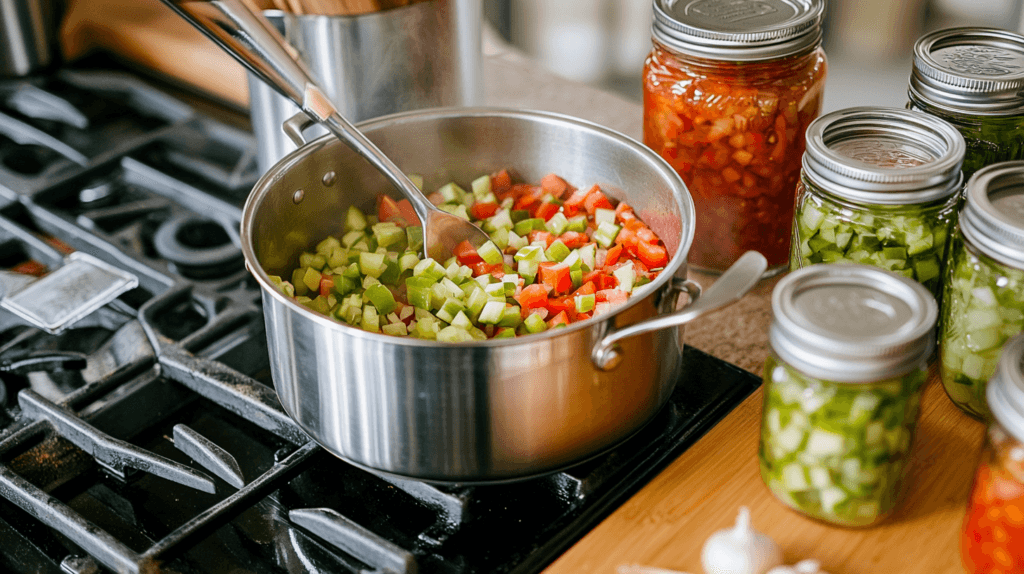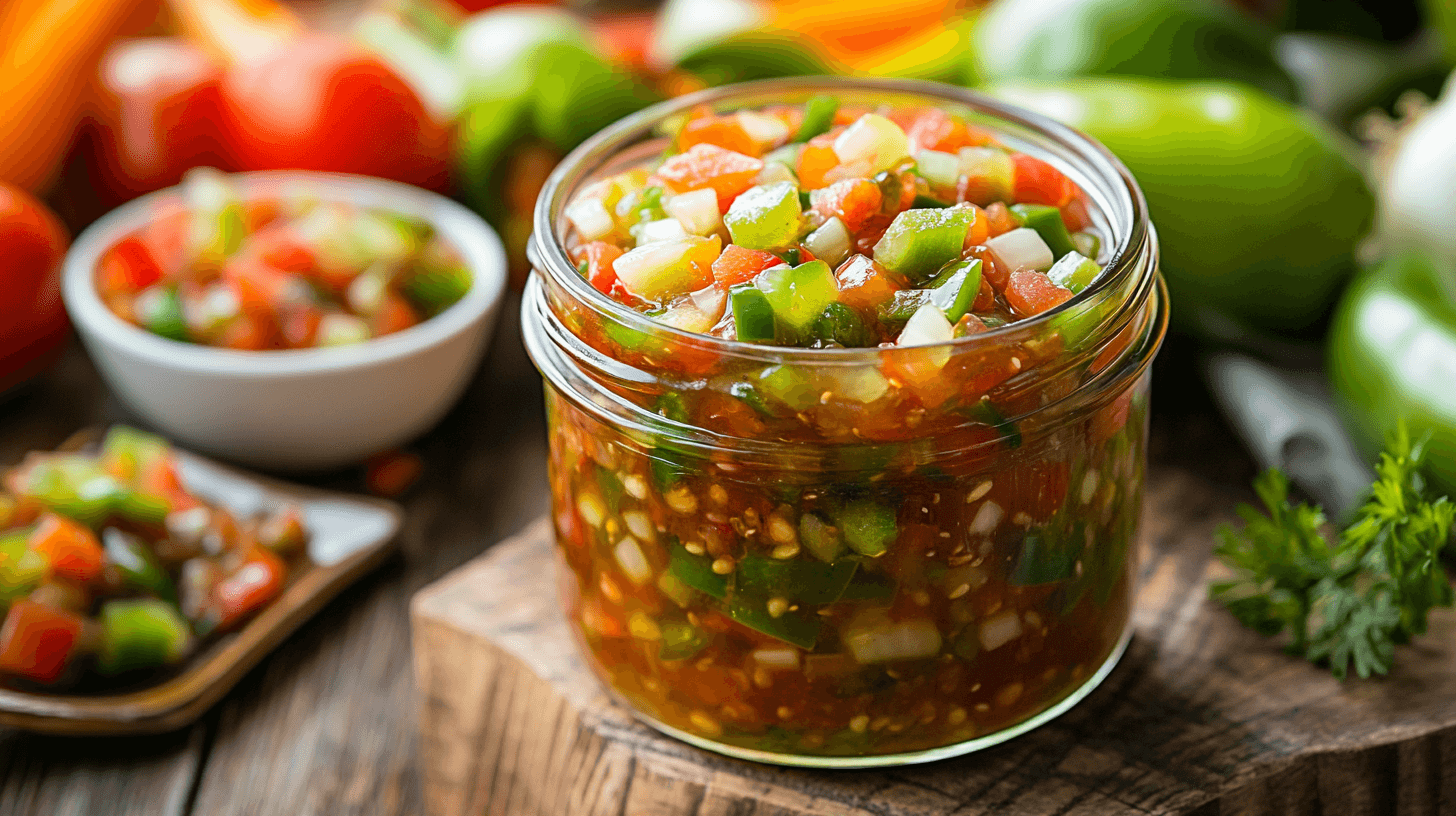Last updated on April 29th, 2025
Chow chow Recipe is more than just a condiment; it’s a versatile and flavorful relish that can transform your meals. This tangy mix of vegetables and spices is perfect for preserving the bounty of seasonal produce while adding a burst of sweet, savory, and spicy flavors to your dishes. Whether paired with Southern classics like cornbread and beans or used to enhance charcuterie boards, chow chow is a must try recipe for every kitchen.
This guide will walk you through the essentials of making and using chow chow. Along the way, we’ll share tips, creative variations, and internal links to related recipes, helping you make the most of this delicious relish.
Table of Contents
What is Chow Chow?
At its core, chow chow is a tangy vegetable relish made with green tomatoes, onions, and peppers. Cooked in a vinegar based brine with sugar and spices, it achieves a perfect balance of tangy and sweet flavors. Traditionally, it’s associated with Southern cooking, where it has long been a favorite way to preserve vegetables. However, versions of chow chow also appear in Canadian and Chinese cuisines, showcasing its global appeal.
One of the great things about chow chow is its adaptability. It can be mild, sweet, or spicy, depending on your preferences. Plus, it’s a fantastic way to reduce food waste by using up end of season vegetables. If you enjoy experimenting with creative side dishes, don’t miss this Baked Bean Recipe, which pairs beautifully with chow chow for a hearty, Southern inspired meal.
🌶️ Chow Chow vs. Piccalilli: What’s the Difference?
Chow chow and piccalilli might look similar in the jar, but they’re two distinct condiments with unique flavor profiles, ingredients, and origins. If you’ve ever wondered what sets them apart, here’s a quick breakdown.
Origin and Influence:
Chow chow is a Southern staple in the United States, often used as a way to preserve end of season vegetables. It’s typically made with cabbage, peppers, onions, and a vinegar based brine. Piccalilli, on the other hand, has British roots and is closely related to Indian pickling traditions.
Flavor and Spice:
Chow chow offers a tangy, slightly sweet and zesty flavor with just a hint of spice. It’s more about the vegetable forward freshness and crunch. Piccalilli, however, leans heavily on mustard, turmeric, and sometimes curry powder, giving it a bold, sharp, and earthy kick.
Texture and Appearance:
Chow chow usually has a chunkier texture with clearly visible bits of vegetables. Piccalilli is often more finely chopped, resulting in a smoother, almost relish like consistency with a vivid yellow hue from the turmeric.
How They’re Used:
Both are great as condiments, but chow chow is more commonly used in Southern U.S. dishes like on beans, hot dogs, or with cornbread. Piccalilli is often served alongside British dishes like cold meats, cheeses, and savory pies.
So while they may share a shelf in the pickling world, chow chow and piccalilli each bring their own personality to the plate.

Ingredients for Chow Chow
The beauty of chow chow lies in its simplicity. The ingredients are easy to find, and many are likely already in your pantry.
Core Vegetables:
- 12 ½ pounds green tomatoes, finely chopped
- 8 large onions, diced
- 10 green bell peppers, chopped
- 6 green chile peppers, chopped (optional for spice)
Tangy Base:
- 1 quart distilled white vinegar
- 1 ¾ cups white sugar
- ½ cup prepared horseradish
Aromatic Spices:
- 1 tablespoon ground cinnamon
- 1 tablespoon ground allspice
- ¼ teaspoon ground cloves
- Salt to taste
These ingredients come together to create a relish that’s as flavorful as it is versatile. Want more ideas for bold condiments? Try this Seafood Boil Sauce Recipe for a rich, spicy accompaniment to your meals.
Step by Step Instructions
1. Prep the Vegetables
- Wash and chop all vegetables into small, even pieces for uniform cooking.
- Combine the chopped vegetables in a large bowl, sprinkle generously with salt, and let sit overnight. This step draws out excess moisture, intensifying the flavor and improving the texture of the final product.
2. Cook the Chow Chow Mixture
- Drain the vegetables and transfer them to a large, heavy bottomed pot.
- Add the vinegar, sugar, horseradish, and spices, stirring well to combine.
- Bring the mixture to a boil, then reduce the heat and let it simmer gently for 15-20 minutes. Stir occasionally until the vegetables become tender and the brine thickens slightly.
3. Preserve the Chow Chow
- Sterilize glass jars and lids by boiling them in water for 10 minutes to ensure a safe seal.
- While the chow chow is still hot, pack it into the sterilized jars, leaving about ½ inch of headspace at the top.
- Seal the jars tightly, then process them in a boiling water bath for 10-15 minutes. This step ensures the chow chow is shelf stable and safe for long term storage.
For detailed food preservation techniques, check out the National Center for Home Food Preservation for expert advice on canning and processing.
🧑🍳 Small Batch Chow Chow (For Beginners or Small Households)
Don’t need a dozen jars of relish cluttering your shelves? No problem. This small batch chow chow method gives you all the bold, tangy flavor of the full-size recipe without the giant commitment. It’s perfect for first time makers, small households, or anyone who just wants to try it before going all in.
Scale It Down:
Use one quarter of the original ingredient quantities to make a manageable 2 to 3 jar yield. That’s just enough to enjoy it fresh over a few weeks without needing a big canning setup.
Skip the Canning Process:
If you plan to eat your chow chow within 2 to 3 weeks, you can skip the boiling water bath entirely. Just pour the hot relish into clean, sterilized jars, let it cool, and refrigerate immediately. It’s the quickest way to go from chopping board to condiment shelf.
Quick Pickle Twist:
Want it even faster? You can make a no-cook version by tossing your chopped veggies in vinegar, sugar, and spices, letting it marinate for 24 hours. It won’t have the same deep flavor but works great in a pinch.
A small batch is a low-risk, high-reward way to dip your toe into the world of homemade chow chow and once you taste it, don’t be surprised if you’re ready for a big batch next time.

Creative Variations of Chow Chow
One of the best things about chow chow is how customizable it is. Here are a few variations to try:
1. Southern Style Chow Chow
- Add shredded cabbage for extra crunch and brown sugar for a sweeter flavor profile. This version pairs wonderfully with baked beans and cornbread.
2. Spicy Chow Chow
- Turn up the heat by increasing the amount of chile peppers or adding a teaspoon of red pepper flakes. This fiery version works well as a topping for tacos or grilled meats.
3. Sweet Chow Chow
- Use more sugar and slightly less vinegar for a mellower, sweeter relish. This version is perfect for serving with crackers and cheese or on charcuterie boards.
🫙 Storage Tips: How to Store Chow Chow for Maximum Freshness
Once you’ve put the time into making chow chow, the last thing you want is to lose its flavor or spoil it before you enjoy it. With the right storage methods, your homemade relish can stay fresh and tasty for months.
Unopened, properly canned chow chow can last up to a year when stored in a cool, dark place like a pantry or cellar. Make sure the jars are sealed tightly and have been processed in a boiling water bath for food safety. Always label your jars with the date you canned them so you know when to rotate or restock.
Once opened, keep your jar of chow chow in the refrigerator. It will stay fresh for up to one month. Use a clean spoon each time to avoid introducing bacteria, and always close the lid tightly after each use.
Want to extend its shelf life even more? Try vacuum sealing the jars if you plan to store them for longer than a year, or use smaller jars to avoid waste if you only use it occasionally.
Signs that chow chow has gone bad include mold, a sour smell, or bubbling liquid. If anything seems off better safe than sorry discard it.
Proper storage protects all the work you’ve done and keeps that bold, tangy flavor ready to use anytime.
How to Use Chow Chow in Meals
Not sure how to incorporate chow chow into your cooking? Here are a few ideas:
- Top It: Spoon chow chow over hot dogs, burgers, or tacos for a tangy flavor boost.
- Side Dish: Serve it alongside Southern staples like cornbread, black eyed peas, or fried chicken.
- Dip It: Mix chow chow with cream cheese for a simple, crowd pleasing dip.
- Garnish: Add it to charcuterie boards for a flavorful accent that pairs beautifully with cured meats and cheeses.
For more side dish inspiration, try Chicken Wings or Smoked Queso Dip to create a well rounded, flavor packed meal.
Why Chow Chow is Worth Making
Whether you’re looking to preserve seasonal produce, add excitement to your meals, or explore new flavors, chow chow is a versatile and satisfying recipe to master. It’s easy to make, lasts for months when properly preserved, and can be adapted to suit your taste preferences. Plus, it’s a great way to reduce food waste by using up end-of-season vegetables.
By following this guide, you’ll create a relish that’s both delicious and practical. Ready to start? Roll up your sleeves and enjoy the process of making your own homemade chow chow!
Frequently Asked Questions (FAQs)
Q1. What is chow chow made of?
Chow chow is a tangy, flavorful relish crafted from a combination of vegetables and spices. Its core ingredients typically include green tomatoes, onions, and peppers, which are chopped and cooked in a vinegar brine. This brine is sweetened with sugar and infused with spices like cinnamon, allspice, and cloves, creating a balance of sweet, spicy, and tangy flavors. Additional ingredients like horseradish or chile peppers can be included for extra heat and zest, making it customizable to your taste preferences.
Q2. Is chow chow a Southern dish?
Yes, chow chow is widely recognized as a Southern staple and has been a beloved condiment in the region for generations. It originated as a way to preserve vegetables at the end of the growing season, ensuring no produce went to waste. While its roots are firmly planted in Southern cuisine, variations of chow chow can be found in other culinary traditions as well. For instance, Canadian versions are often sweeter, while Chinese chow chow features bolder spices. Its adaptability across cultures speaks to its universal appeal.
Q3. Can I make chow chow less spicy?
Absolutely! If you prefer a milder chow chow, it’s easy to adjust the spice level to suit your taste. Here’s how:
- Reduce or omit the chile peppers: Simply leave out the green chiles or hot peppers listed in the recipe.
- Swap out spicy peppers: Replace hot peppers with mild bell peppers for a tangy but heat
- free relish.
- Balance the flavor: Increase the sugar slightly to offset the spiciness, creating a sweeter profile.
By tailoring the ingredients, you can enjoy chow chow that’s flavorful without being too fiery.
Q4. How long does chow chow last?
When properly canned and stored, chow chow can last up to a year in a cool, dark place like a pantry. The vinegar brine acts as a natural preservative, ensuring the relish maintains its quality over time.
Once you open a jar of chow chow, it should be refrigerated and consumed within one month for the best flavor and freshness. For extended shelf life, ensure your canning process follows safety guidelines, such as sterilizing jars and processing them in a boiling water bath. Check out the USDA Guidelines for Food Preservation for tips on proper storage and handling.
Q5. Can I freeze chow chow?
Yes, chow chow can be frozen and still retain its vibrant flavor and texture. To freeze chow chow:
- Use airtight containers or freezer safe bags: Ensure there’s no air inside to prevent freezer burn.
- Label and date your containers: This helps you keep track of how long it has been frozen.
- Freeze for up to six months: While frozen chow chow won’t have the same crispness as fresh, it remains delicious and versatile for meals.
Freezing is an excellent option if you’re not set up for canning or want to preserve smaller batches.
Final Thoughts
Chow chow is more than a condiment; it’s a culinary treasure that can enhance almost any meal. Whether you prefer a spicy version for tacos, a sweet Southern style twist for cornbread, or a tangy garnish for burgers, chow chow offers endless versatility. Plus, it’s a fantastic way to preserve fresh vegetables, ensuring nothing from your harvest goes to waste.
Want to explore more creative ways to use chow chow? Pair it with a Crab Brulee Recipe for a luxurious appetizer that perfectly complements its bold flavors.

Classic Southern Chow Chow Relish
Equipment
- Large Bowl
- Colander
- Large Pot
- Canning Jars
- Ladle
- Jar Funnel (optional)
Ingredients
Vegetables
- 4 cups green cabbage finely chopped
- 2 cups green tomatoes chopped
- 1 cup onion chopped
- 1 cup bell pepper chopped (red or green)
- 1 cup carrot grated
Brine
- 3 cups apple cider vinegar
- 1.5 cups granulated sugar
- 2 tablespoons mustard seeds
- 1 tablespoon celery seed
- 1 teaspoon turmeric
- 2 tablespoons kosher salt
Instructions
- In a large bowl, combine all chopped vegetables. Sprinkle with 2 tablespoons of salt and toss well. Let sit overnight (8 hours) to release water.
- Drain vegetables in a colander, pressing out excess liquid.
- In a large pot, combine vinegar, sugar, mustard seeds, celery seed, and turmeric. Bring to a boil.
- Add drained vegetables and return to a boil. Reduce heat and simmer for 10–15 minutes, stirring occasionally.
- Ladle hot relish into sterilized jars, leaving 1/2 inch headspace. Wipe rims, apply lids, and process in a boiling water bath for 10 minutes.
